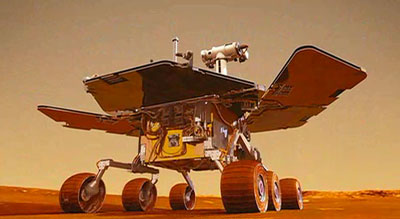Review: Roving Mars in IMAXby Jeff Foust
|
| Roving Mars is about much more than the rovers’ travels on the surface of Mars. Much of the movie focuses instead on the work required to build the rovers. |
So, for those of us stuck on Earth (or at least in cislunar space) for the foreseeable future, what’s the next best thing? Some sort of virtual exploration is called for, and while we’re still a long way from Star Trek’s holodeck, advances in both reality (cinematography and robotic spacecraft) and fantasy (special effects) are making such experiences more realistic and immersive. The latest such attempt to virtually transport people to the Red Planet is Roving Mars, the new IMAX movie about the twin Mars Exploration Rovers, and the results are mixed.
Roving Mars is about much more than the rovers’ travels on the surface of Mars. Much of the movie focuses instead on the work required to build the rovers, including the struggles to get the rover, including its airbags and parachutes, ready in time for launch. The movie then covers the launch of the rovers and their landing on the Red Planet, using a mix of actual footage and detailed computer animations. Only late in the movie—no more than the final third or so—do we finally see the rovers moving across the Martian surface and making discoveries that support the notion that the planet once had liquid water on its surface.
One challenge with Roving Mars is that Spirit and Opportunity were not equipped with IMAX cameras; even if they were, there would be no way to film themselves landing on Mars or rolling across the terrain. It’s a challenge similar to that faced by the producers of another recent IMAX space movie, Magnificent Desolation (see “Review: Magnificent Desolation”, The Space Review, September 26, 2005): after all, the Apollo astronauts did not carry IMAX cameras on their expeditions. Magnificent Desolation solved that problem by meticulously recreating the Apollo moonwalks on a soundstage, adding computer-generated special effects where necessary. In this case, producers relied on “IMAX-quality” still images taken by the rovers, integrated into computer-generated animations created by Dan Maas (who created stunning pre-launch animations of the mission while still a student at Cornell University). The result is something both as realistic and accurate as possible given the limitations of contemporary technology: for example, every bounce by the airbag-swaddled rovers shown in the movie is based on the telemetry from the rovers’ actual landings.
| Some elements of the movie, such as the depictions of the launch and landing of the rovers, are superb, especially when seen and heard in IMAX. The launch in particular is breathtaking, having combined actual footage and computer animations almost seamlessly. |
The movie is as much about the people who built and operated the rovers, though, as it is about the rovers themselves. There is considerable footage of the assembly and testing of the rovers at JPL, and later footage from the control room when the first rover, Spirit, landed. The movie eschews the celebrity narration often used in IMAX movies in favor of commentary from the likes of project scientist Steve Squyres and Rob Manning, who led the entry, descent, and landing team for the rover project. (There is an opening narration by a gravelly-voiced Paul Newman, who sounds more like Walter Cronkite than the star of The Sting and The Hustler). An ethereal soundtrack by composer Phillip Glass and the group Sigur Rós blends into the background so much that that average viewer may not notice it at all, at least until near the end.
Does the movie succeed in transporting the viewer to Mars? For the space-savvy person, the results may not be overwhelming. The trials and tribulations of developing the rovers are old hat to many, who have either read about the mission in Squyres book of the same name (See “Review: Roving Mars”, The Space Review, August 29, 2005), or seen the PBS Nova documentary about the mission; seeing much the same thing on the huge IMAX screen does not add much additional value. On the other hand, some elements of the movie, such as the depictions of the launch and landing of the rovers, are superb, especially when seen and heard in IMAX. The launch in particular is breathtaking, having combined actual footage and computer animations almost seamlessly—the computer-generated footage is obvious only because it comes from vantage points where it would be impossible to mount a real camera.
Of course, IMAX movies aren’t made just—or even primarily—for space enthusiasts, but rather for the general public, or at least those people who go to the museums where so many IMAX theaters are located. Does it work for them? During a screening at the movie’s premiere Thursday night at the National Air and Space Museum in Washington, I noticed a glow in the corner of my eye during the final portions of the movie. I looked over and saw, a few seats down, a teenage girl who had pulled out her cell phone, perhaps to furtively text a friend. Evidently the movie wasn’t that compelling to her, but then, she may not harbor any desires to walk on the surface of Mars herself some day. For those who do, though, Roving Mars will serve as an acceptable substitute—at least for now.
